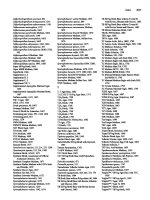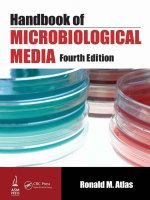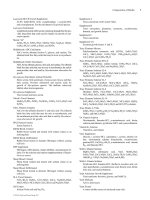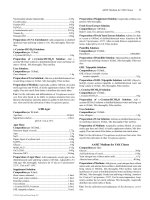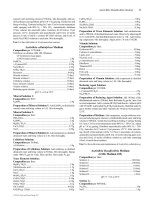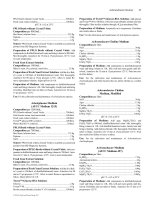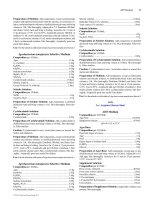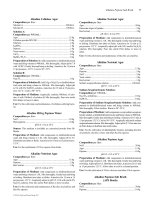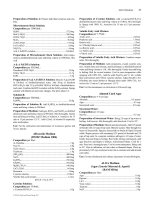Handbook of Microbiological Media, Fourth Edition part 66 ppt
Bạn đang xem bản rút gọn của tài liệu. Xem và tải ngay bản đầy đủ của tài liệu tại đây (219.61 KB, 10 trang )
Enrichment Broth, pH 7.3 with Pyruvate 645
Preparation of Medium: Add components to distilled/deionized
water and bring volume to 1.0L. Mix thoroughly. Distribute into tubes
or flasks. Autoclave for 15 min at 15 psi pressure–121°C. Prepare
freshly or boil and cool the medium just before use.
Use: For the cultivation of both aerobic and anaerobic organisms. For
the performance of sterility tests of turbid or viscous specimens.
Enrichment Broth for Aeromonas hydrophila
Composition per liter:
NaCl 5.0g
Maltose 3.5g
Yeast extract 3.0g
Bile salts No. 3 1.0g
L-Cysteine·HCl·H
2
O 0.3g
Bromthymol Blue 0.03g
Novobiocin 5.0mg
pH 7.0 ± 0.2 at 25°C
Preparation of Medium: Add components to distilled/deionized
water and bring volume to 1.0L. Mix thoroughly. Distribute into tubes
or flasks. Autoclave for 15 min at 15 psi pressure–121°C.
Use: For the cultivation and enrichment of Aeromonas hydrophila.
Enrichment Broth, pH 7.3
Composition per liter:
Pancreatic digest of casein 17.0g
Yeast extract 6.0g
NaCl 5.0g
Papaic digest of soybean meal 3.0g
Glucose 2.5g
K
2
HPO
4
2.5g
Nalidixic acid solution 8.0mL
Cycloheximide solution 5.1mL
Acriflavin·HCl solution 3.0mL
pH 7.3 ± 0.2 at 25°C
Cycloheximide Solution:
Composition
per 10.0mL:
Cycloheximide 0.1g
Ethanol, absolute 4.0mL
Preparation of Cycloheximide Solution: Add components to
distilled/deionized water and bring volume to 10.0mL. Mix thorough-
ly. Filter sterilize.
Caution: Cycloheximide is toxic. Avoid skin contact or aerosol for-
mation and inhalation.
Nalidixic Acid Solution:
Composition
per 10.0mL:
Nalidixic acid 0.05g
Preparation of Nalidixic Acid Solution: Add nalidixic acid to
distilled/deionized water and bring volume to 10.0mL. Mix thorough-
ly. Filter sterilize.
Acriflavin·HCl Solution:
Composition
per 10.0mL:
Acriflavin·HCl 0.05g
Preparation of Acriflavin·HCl Solution: Add acriflavin·HCl to
distilled/deionized water and bring volume to 10.0mL. Mix thorough-
ly. Filter sterilize.
Preparation of Medium: Add components—except cyclohexim-
ide solution, nalidixic acid solution, and acriflavin·HCl solution—to
distilled/deionized water and bring volume to 983.9mL. Mix thorough-
ly. Gently heat and bring to boiling. Autoclave for 15 min at 15 psi
pressure–121°C. Cool to 45°–50°C. Aseptically add 5.1mL of sterile
cycloheximide solution, 8.0mL of sterile nalidixic acid solution, and
3.0mL of sterile acriflavin·HCl solution. Mix thoroughly. Aseptically
distribute into sterile tubes.
Use: For the isolation, cultivation, and enrichment of a variety of
microorganisms from nondairy foods.
Enrichment Broth, pH 7.3
Composition per liter:
Pancreatic digest of casein 17.0g
Yeast extract 6.0g
NaCl 5.0g
Papaic digest of soybean meal 3.0g
Glucose 2.5g
K
2
HPO
4
2.5g
Nalidixic acid solution 8.0mL
Cycloheximide solution 5.1mL
Acriflavin·HCl solution 2.0mL
pH 7.3 ± 0.2 at 25°C
Cycloheximide Solution:
Composition
per 10.0mL:
Cycloheximide 0.1g
Ethanol, absolute 4.0mL
Preparation of Cycloheximide Solution: Add components to
distilled/deionized water and bring volume to 10.0mL. Mix thorough-
ly. Filter sterilize.
Caution: Cycloheximide is toxic. Avoid skin contact or aerosol for-
mation and inhalation.
Nalidixic Acid Solution:
Composition
per 10.0mL:
Nalidixic acid 0.05g
Preparation of Nalidixic Acid Solution: Add nalidixic acid to
distilled/deionized water and bring volume to 10.0mL. Mix thorough-
ly. Filter sterilize.
Acriflavin·HCl Solution:
Composition
per 10.0mL:
Acriflavin·HCl 0.05g
Preparation of Acriflavin·HCl Solution: Add acriflavin·HCl to
distilled/deionized water and bring volume to 10.0mL. Mix thorough-
ly. Filter sterilize.
Preparation of Medium: Add components—except cyclohexim-
ide solution, nalidixic acid solution, and acriflavin·HCl solution—to
distilled/deionized water and bring volume to 984.9mL. Mix thorough-
ly. Gently heat and bring to boiling. Autoclave for 15 min at 15 psi
pressure–121°C. Cool to 45°–50°C. Aseptically add 5.1mL of cyclo-
heximide solution, 8.0mL of nalidixic acid solution, and 2.0mL of
acriflavin·HCl solution. Mix thoroughly. Aseptically distribute into
sterile tubes.
Use: For the isolation, cultivation, and enrichment of a variety of
microorganisms from milk and dairy products.
Enrichment Broth, pH 7.3 with Pyruvate
Composition per liter:
Pancreatic digest of casein 17.0g
Yeast extract 6.0g
© 2010 by Taylor and Francis Group, LLC
646 Enrichment Broth, pH 7.3 with Pyruvate
NaCl 5.0g
Papaic digest of soybean meal 3.0g
Glucose 2.5g
K
2
HPO
4
2.5g
Pyruvate solution 11.1mL
Nalidixic acid solution 8.0mL
Cycloheximide solution 5.1mL
Acriflavin·HCl solution 3.0mL
pH 7.3 ± 0.2 at 25°C
Pyruvate Solution:
Composition
per 20.0mL:
Sodium pyruvate 2.0g
Preparation of Pyruvate Solution: Add sodium pyruvate to dis-
tilled/deionized water and bring volume to 20.0mL. Mix thoroughly.
Filter sterilize.
Cycloheximide Solution:
Composition
per 10.0mL:
Cycloheximide 0.1g
Ethanol, absolute 4.0mL
Preparation of Cycloheximide Solution: Add components to
distilled/deionized water and bring volume to 10.0mL. Mix thorough-
ly. Filter sterilize.
Caution: Cycloheximide is toxic. Avoid skin contact or aerosol for-
mation and inhalation.
Nalidixic Acid Solution:
Composition
per 10.0mL:
Nalidixic acid 0.05g
Preparation of Nalidixic Acid Solution: Add nalidixic acid to
distilled/deionized water and bring volume to 10.0mL. Mix thorough-
ly. Filter sterilize.
Acriflavin·HCl Solution:
Composition
per 10.0mL:
Acriflavin·HCl 0.05g
Preparation of Acriflavin·HCl Solution: Add acriflavin·HCl to
distilled/deionized water and bring volume to 10.0mL. Mix thorough-
ly. Filter sterilize.
Preparation of Medium: Add components—except pyruvate solu-
tion, cycloheximide solution, nalidixic acid solution, and acriflavin·HCl
solution—to distilled/deionized water and bring volume to 972.8mL.
Mix thoroughly. Gently heat and bring to boiling. Autoclave for 15 min
at 15 psi pressure–121°C. Cool to 45°–50°C. Aseptically add 11.1mL
of sterile pyruvate solution. Mix thoroughly. Inoculate medium and in-
cubate at 30°C for 6 hr. Aseptically add 5.1mL of sterile cycloheximide
solution, 8.0mL of sterile nalidixic acid solution, and 3.0mL of sterile
acriflavin·HCl solution. Mix thoroughly.
Use: For the isolation, cultivation, and enrichment of Listeria species
from nondairy foods.
Enrichment Broth, pH 7.3 with Pyruvate
Composition per liter:
Pancreatic digest of casein 17.0g
NaCl 5.0g
Papaic digest of soybean meal 3.0g
Glucose 2.5g
K
2
HPO
4
2.5g
Yeast extract 6.0g
Pyruvate solution 11.1mL
Nalidixic acid solution 8.0mL
Cycloheximide solution 5.1mL
Acriflavin·HCl solution 2.0mL
pH 7.3 ± 0.2 at 25°C
Pyruvate Solution:
Composition
per 20.0mL:
Sodium pyruvate 2.0g
Preparation of Pyruvate Solution: Add sodium pyruvate to dis-
tilled/deionized water and bring volume to 20.0mL. Mix thoroughly.
Filter sterilize.
Cycloheximide Solution:
Composition
per 10.0mL:
Cycloheximide 0.1g
Ethanol, absolute 4.0mL
Preparation of Cycloheximide Solution: Add components to
distilled/deionized water and bring volume to 10.0mL. Mix thorough-
ly. Filter sterilize.
Caution: Cycloheximide is toxic. Avoid skin contact or aerosol for-
mation and inhalation.
Nalidixic Acid Solution:
Composition
per 10.0mL:
Nalidixic acid 0.05g
Preparation of Nalidixic Acid Solution: Add nalidixic acid to
distilled/deionized water and bring volume to 10.0mL. Mix thorough-
ly. Filter sterilize.
Acriflavin·HCl Solution:
Composition
per 10.0mL:
Acriflavin·HCl 0.05g
Preparation of Acriflavin·HCl Solution: Add acriflavin·HCl to
distilled/deionized water and bring volume to 10.0mL. Mix thorough-
ly. Filter sterilize.
Preparation of Medium: Add components—except pyruvate solu-
tion, cycloheximide solution, nalidixic acid solution, and acriflavin·HCl
solution—to distilled/deionized water and bring volume to 973.8mL.
Mix thoroughly. Gently heat and bring to boiling. Autoclave for 15 min
at 15 psi pressure–121°C. Cool to 45°–50°C. Aseptically add 11.1mL
of sterile pyruvate solution. Mix thoroughly. Inoculate medium and in-
cubate at 30°C for 6 hr. Aseptically add 5.1mL of sterile cycloheximide
solution, 8.0mL of sterile nalidixic acid solution, and 2.0mL of sterile
acriflavin·HCl solution. Mix thoroughly.
Use: For the isolation, cultivation, and enrichment of Listeria species
from milk and dairy products.
Entamoeba dispar Axenic
Culture Medium
Composition per liter:
YI-S solution 990.0mL
Gastric mucin stock suspension 10.0mL
YI-S Solution:
Composition
per liter:
YI broth 880.0mL
Bovine serum, heat inactivated 100.0mL
Vitamin mixture 18 20.0mL
Source: Vitamin mixture 18 is available from Biofluids, Rockville, MD.
© 2010 by Taylor and Francis Group, LLC
Enteric Fermentation Base 647
YI Broth:
Composition
per liter:
YI base stock 780.0mL
10× Glucose buffer stock 100.0mL
YI Base Stock:
Composition
per 780.0mL:
Yeast extract 30.0g
L-Cysteine·HCl 1.0g
NaCl 1.0g
Ascorbic acid 0.2g
Ferric ammonium citrate 228.0mg
10× Glucose Buffer Stock:
Composition
per 100.0.0mL:
Glucose 10.0g
K
2
HPO
4
1.0g
KH
2
PO
4
0.6g
Preparation of 10× Glucose Buffer Stock: Add components to
distilled/deionized water and bring volume to 100.0mL. Mix thorough-
ly. Filter sterilize.
Preparation of YI Base Stock: Add components to 600.0mL of
distilled/deionized water. Mix thoroughly. Bring volume to 780.0mL
with distilled/deionized water. Adjust pH to 6.8 with 1N NaOH. Dis-
tribute in 78.0mL aliquots to 100.0mL screw-capped bottles. Auto-
clave for 15 min at 15 psi pressure–121°C. Cool to room temperature.
Preparation of YI Broth: Aseptically add 10.0mL of 10× glucose
buffer stock to 78.0mL of cooled YI base stock. Adjust osmolarity with
NaCl to 380.0milliosmols/kg.
Preparation of YI-S Solution: Aseptically add 2.0mL of vitamin
mixture 18 and 10.0mL of heat-inactivated bovine serum to 88.0mL of
YI broth. Distribute in 12.0mL aliquots to 16 x 125mm screw-capped
test tubes. Store at 4°C in the dark with the caps screwed on tightly. Use
within 96 hr.
Gastric Mucin Stock Suspension:
Composition
per 100.0mL:
Gastric mucin 1.0g
Preparation of Gastric Mucin Stock Suspension: Add gastric
mucin to distilled/deionized water and bring volume to 100.0mL. Mix
thoroughly. Autoclave for 15 min at 15 psi pressure–121°C.
Preparation of Medium: Aseptically add 0.12mL of gastric mucin
stock suspension (thoroughly mix by swirling before use) to 12.0mL of
the complete YI-S solution in a 16 x 125mm screw-capped test tube.
Store at 4°C in the dark with the caps screwed on tightly. Use within 96
hrs.
Use: For the cultivation of Entamoeba dispar.
Entamoeba HiVeg Medium
Composition per liter:
Agar 11.0g
Plant infusion No. 1 10.8g
Plant peptone No. 3 5.5g
Sodium glycerophosphate 3.0g
NaCl 2.7g
pH 7.0 ± 0.2 at 25°C
Source: This medium is available as a premixed powder from Hi-
Media.
Preparation of Medium: Add components to distilled/deionized
water and bring volume to 1.0L. Mix thoroughly. Gently heat and bring
to boiling. Distribute into tubes or flasks. Autoclave for 15 min at 15
psi pressure–121°C. Allow the tubes to solidify in a slanted position.
Cover about half of the slant with fresh sterile horse seum saline mix-
ture (1:6) and add a 5mm loopful of rice powder that has been sterilized
in an oven at 160°C. Scorching should be prevented.
Use: For the cultivation of Entamoeba histolytica.
Entamoeba Medium
(Endamoeba Medium)
Composition per liter:
Liver infusion 272.0g
Rice powder 14.2g
Agar 11.0g
Proteose peptone 5.5g
Sodium glycerophosphate 3.0g
NaCl 2.7g
Horse serum 50.0mL
pH 7.0 ± 0.2 at 25°C
Source: This medium is available as a premixed powder from BD Di-
agnostic Systems.
Rice Powder:
Composition
per 15.0g:
Rice powder 15.0g
Preparation of Rice Powder: Sterilize rice powder at 160°C for 60
min. Do not overheat or rice powder will scorch.
Preparation of Medium: Add components, except horse serum
and rice powder, to distilled/deionized water and bring volume to
994.0mL. Mix thoroughly. Gently heat and bring to boiling. Distribute
into tubes in 7.0mL volumes. Autoclave for 15 min at 15 psi pressure–
121°C. Allow tubes to cool in a slanted position. Aseptically add
enough sterile horse serum to each tube to cover about half the slant.
Aseptically add 0.1g of sterile rice powder to each tube.
Use: For the cultivation of Entamoeba histolytica.
Enteric Fermentation Base
(Fermentation Base for Campylobacter)
Composition per liter:
Peptic digest of animal tissue 10.0g
NaCl 5.0g
Beef extract 3.0g
Carbohydrate solution 100.0mL
Andrade’s indicator 10.0mL
pH 7.2 ± 0.1 at 25°C
Source: This medium is available as a premixed powder from BD Di-
agnostic Systems.
Carbohydrate Solution:
Composition
per 100.0mL:
Carbohydrate 10.0g
Preparation of Carbohydrate Solution: Add carbohydrate to
distilled/deionized water and bring volume to 100.0mL. Mix thorough-
ly. Filter sterilize. Glucose, lactose, mannitol, sucrose, adonitol, arabi-
nose, cellobiose, dulcitol, glycerol, inositol, salicin, xylose, or other
carbohydrates may be used. For the preparation of expensive carbohy-
drate solutions (adonitol, arabinose, cellobiose, dulcitol, glycerol, inos-
itol, salicin, or xylose), 5.0g of carbohydrate
per 100.0mL of distilled/
deionized water may be used.
© 2010 by Taylor and Francis Group, LLC
648 Enterobacter Medium
Andrade’s Indicator:
Composition
per 100.0mL:
NaOH (1N solution) 16.0mL
Acid Fuchsin 0.1g
Caution: Acid Fuchsin is a potential carcinogen and care must be tak-
en to avoid inhalation of the powdered dye and contact with the skin.
Preparation of Andrade’s Indicator: Add components to dis-
tilled/deionized water and bring volume to 100.0mL. Mix thoroughly.
Preparation of Medium: Add components, except carbohydrate
solution, to distilled/deionized water and bring volume to 900.0mL.
Mix thoroughly. Gently heat and bring to boiling. Distribute into tubes
that contain an inverted Durham tube in 9.0mL volumes. Autoclave for
15 min at 15 psi pressure–121°C. Cool to 25°C. Aseptically add 1.0mL
of sterile carbohydrate solution per tube. Mix thoroughly.
Use: For the cultivation and differentiation of a variety of bacteria
based on their ability to ferment different carbohydrates. Bacteria that
produce acid from carbohydrate fermentation turn the medium dark
pink to red. Bacteria that produce gas have a bubble trapped in the Dur-
ham tube.
Enterobacter Medium
Composition per 800.0mL:
Casein hydrolysate 2.0g
K
2
HPO
4
1.4g
K
2
SO
4
1.0g
Yeast extract 1.0g
KH
2
PO
4
0.6g
MgSO
4
0.5g
Glycerol 20.0mL
Preparation of Medium: Add components to distilled/deionized
water and bring volume to 800.0mL. Mix thoroughly. Distribute into
tubes or flasks. Autoclave for 15 min at 15 psi pressure–121°C.
Use: For the cultivation and maintenance of Enterobacter species and
Klebsiella pneumoniae.
Enterobacteria Enrichment Broth, Mossel
Composition per liter:
Pancreatic digest of gelatin 10.0g
Na
2
HPO
4
, anhydrous 6.4g
Glucose, anhydrous 4.5g
Bile salts (sodium desoxycholate, sodium lauryl sulphate,
sodium citrate) 3.055g
KH
2
PO
4
2.0g
Brilliant Green 0.015g
pH 7.2 ± 0.2 at 25°C
Source: This medium is available as a premixed powder from Oxoid
Unipath.
Preparation of Medium: Add components to distilled/deionized
water and bring volume to 1.0L. Mix thoroughly. Gently heat while
stirring and bring to boiling. Maintain at 100°C for 30 min, typically
using flowing steam. Do not autoclave. Cool rapidly in cold running
water. MixAseptically distribute into tubes or flasks.
Use: For the enrichment of bile-tolerant Gram-negative bacteria in the
microbiological examination of pharmaceutical products.
Enterobacteriaceae Enrichment Broth
See: EE Broth
Enterobacteriaceae Enrichment Broth, Mossel
See: EE Broth, Mossel
Enterococci Broth, Chromocult
(Chromocult Enterococci Broth)
Composition per liter:
Peptone 8.6g
NaCl 6.4g
Tween 80 2.2g
NaN
3
0.6g
5-Bromo-4-chloro-3-indolyl-β-
D-glucopyranoside (X-GLU) 0.04
pH 7.5 ± 0.2 at 25°C
Source: This medium is available from Merck.
Preparation of Medium: Add components to distilled/deionized
water and bring volume to 1.0L. Mix well. Distribute into tubes. Auto-
clave for 15 min at 15 psi pressure–121°C. The prepared broth is clear
and yellowish.
Use: For the detection of enterococci in food and water. The sodium
azide present in this medium largely inhibits the growth of the accom-
panying, and especially the Gram-negative microbial flora while spar-
ing the enterococci. The substrate X-GLU (5-bromo-4-chloro-3-indo-
lyl-β-
D-glucopyranoside) is cleaved, stimulated by selected peptones,
by the enzyme β-D-glucosidase which is characteristic for enterococci.
This results in an intensive blue-green color of the broth. Azide, at the
same time, prevents a false positive result by most other β-
D-glucosi-
dase positive bacteria. Therefore, the color change of the broth largely
confirms the presence of enterococci and group D streptococci.
Enterococci Confirmatory Agar
Composition per liter:
Agar 15.0g
Glucose 5.0g
Pancreatic digest of casein 5.0g
Yeast extract 5.0g
NaN
3
0.4g
Methylene Blue 10.0mg
Enterococci confirmatory broth variable
pH 8.0 ± 0.2 at 25°C
Source: This medium is available as a premixed powder from BD Di-
agnostic Systems.
Caution: Sodium azide is toxic. Azides also react with metals and
disposal must be highly diluted.
Preparation of Medium: Add components to distilled/deionized
water and bring volume to 1.0L. Mix thoroughly. Gently heat and bring
to boiling. Distribute into tubes. Autoclave for 15 min at 15 psi pres-
sure–121°C. Allow tubes to cool in a slanted position. Add sufficient
amount of Enterococci confirmatory broth (see below) to cover half the
slant.
Use: For the identification of enterococci from water by the confirma-
tory test.
Enterococci Confirmatory Broth
Composition per liter:
NaCl 65.0g
Glucose 5.0g
Pancreatic digest of casein 5.0g
Yeast extract 5.0g
NaN
3
0.4g
© 2010 by Taylor and Francis Group, LLC
Enterococcus Confirmatory HiVeg Agar with Penicillin 649
Methylene Blue 10.0mg
Penicillin 650U
pH 8.0 ± 0.2 at 25°C
Source: This medium is available as a premixed powder from BD Di-
agnostic Systems.
Caution: Sodium azide is toxic. Azides also react with metals and
disposal must be highly diluted.
Preparation of Medium: Add components, except penicillin, to
distilled/deionized water and bring volume to 1.0L. Mix thoroughly.
Gently heat and bring to boiling. Autoclave for 15 min at 15 psi pres-
sure–121°C. Cool to 25°C. Aseptically add penicillin. Mix thoroughly.
Use: For the identification of enterococci from water by the confirma-
tory test.
Enterococci Presumptive Broth
Composition per liter:
Glucose 5.0g
Pancreatic digest of casein 5.0g
Yeast extract 5.0g
NaN
3
0.4g
Bromthymol Blue 32.0mg
pH 8.4 ± 0.2 at 25°C
Source: This medium is available as a premixed powder from BD Di-
agnostic Systems.
Caution: Sodium azide is toxic. Azides also react with metals and
disposal must be highly diluted.
Preparation of Medium: Add components to distilled/deionized
water and bring volume to 1.0L. Mix thoroughly. Distribute into tubes
or flasks. Autoclave for 15 min at 15 psi pressure–121°C.
Use: For the isolation and identification of enterococci from water by
the presumptive test. Bacteria that produce acid and turn the medium
yellow and turbid after incubation at 45°C are presumptive entero-
cocci.
Enterococcosel™ Agar
Composition per liter:
Pancreatic digest of casein 17.0g
Agar 13.5g
Oxgall 10.0g
NaCl 5.0g
Yeast extract 5.0g
Peptic digest of animal tissue 3.0g
Esculin 1.0g
Sodium citrate 1.0g
Ferric ammonium citrate 0.5g
NaN
3
0.25g
pH 7.1 ± 0.2 at 25°C
Source: This medium is available as a premixed powder from BD Di-
agnostic Systems.
Caution: Sodium azide is toxic. Azides also react with metals and
disposal must be highly diluted.
Preparation of Medium: Add components to distilled/deionized
water and bring volume to 1.0L. Mix thoroughly. Gently heat while
stirring and bring to boiling. Distribute into tubes or flasks. Autoclave
for 15 min at 15 psi pressure–121°C. Pour into sterile Petri dishes or
leave in tubes.
Use: For the rapid, selective isolation, cultivation, and enumeration of
fecal group D streptococci (enterococci). For the cultivation of staphy-
lococci and Listeria monocytogenes.
Enterococcosel™ Broth
Composition per liter:
Pancreatic digest of casein 17.0g
Oxgall 10.0g
NaCl 5.0g
Yeast extract 5.0g
Peptic digest of animal tissue 3.0g
Esculin 1.0g
Sodium citrate 1.0g
Ferric ammonium citrate 0.5g
NaN
3
0.25g
pH 7.1 ± 0.2 at 25°C
Source: This medium is available as a premixed powder from BD Di-
agnostic Systems.
Caution: Sodium azide is toxic. Azides also react with metals and
disposal must be highly diluted.
Preparation of Medium: Add components to distilled/deionized
water and bring volume to 1.0L. Mix thoroughly. Gently heat while
stirring until dissolved. Distribute into tubes or flasks. Autoclave for 15
min at 15 psi pressure–121°C.
Use: For the cultivation and differentiation of group D streptococci
(enterococci).
Enterococcus Agar
(m-Enterococcus Agar)
(Azide Agar)
Composition per liter:
Pancreatic digest of casein 15.0g
Agar 10.0g
Papaic digest of soybean meal 5.0g
Yeast extract 5.0g
KH
2
PO
4
4.0g
Glucose 2.0g
NaN
3
0.4g
Triphenyltetrazolium chloride 0.1g
pH 7.2 ± 0.2 at 25°C
Source: This medium is available as a premixed powder from BD Di-
agnostic Systems.
Caution: Sodium azide is toxic. Azides also react with metals and
disposal must be highly diluted.
Preparation of Medium: Add components to distilled/deionized
water and bring volume to 1.0L. Mix thoroughly. Gently heat and bring
to boiling. Cool to 45°–50°C. Do not autoclave. Pour into sterile Petri
dishes.
Use: For the isolation, cultivation, and enumeration of entercocci in
water, sewage, and feces by the membrane filter method. For the direct
plating of specimens for the detection and enumeration of fecal strep-
tococci.
Enterococcus Confirmatory HiVeg Agar
with Penicillin
Composition per liter:
Agar 15.0g
Glucose 5.0g
Plant hydrolysate 5.0g
© 2010 by Taylor and Francis Group, LLC
650 Enterococcus Confirmatory HiVeg Broth with Penicillin
Yeast extract 5.0g
NaN
3
0.4g
Methylene Blue 0.01g
Penicillin solution 10.0mL
pH 8.0± 0.2 at 25°C
Source: This medium, without penicillin, is available as a premixed
powder from HiMedia.
Caution: Sodium azide is toxic. Azides also react with metals and
disposal must be highly diluted.
Penicillin Solution:
Composition
per 10.0mL:
Penicillin 650U
Preparation of Penicillin Solution: Add penicillin to distilled/de-
ionized water and bring volume to 10.0mL. Mix thoroughly. Filter ster-
ilize.
Preparation of Medium: Add components, except penicillin solu-
tion, to distilled/deionized water and bring volume to 1.0L. Mix thor-
oughly. Gently heat and bring to boiling. Autoclave for 15 min at 15 psi
pressure–121°C. Cool to 45°–50°C. Aseptically add 10.0mL sterile pen-
icillin solution. Mix thoroughly. Pour into sterile Petri dishes or dispense
into sterile tubes.
Use: For the isolation, cultivation, and enumeration of entercocci in
water, sewage, and feces by the membrane filter method. For the direct
plating of specimens for the detection and enumeration of fecal strep-
tococci.
Enterococcus Confirmatory HiVeg Broth
with Penicillin
Composition per liter:
NaCl 65.0g
Glucose 5.0g
Plant hydrolysate 5.0g
Yeast extract 5.0g
NaN
3
0.4g
Methylene Blue 0.01g
Penicillin solution 10.0mL
pH 8.0 ± 0.2 at 25°C
Source: This medium, without penicillin, is available as a premixed
powder from HiMedia.
Caution: Sodium azide is toxic. Azides also react with metals and
disposal must be highly diluted.
Penicillin Solution:
Composition
per 10.0mL:
Penicillin 650U
Preparation of Penicillin Solution: Add penicillin to distilled/de-
ionized water and bring volume to 10.0mL. Mix thoroughly. Filter ster-
ilize.
Preparation of Medium: Add components, except penicillin solu-
tion, to distilled/deionized water and bring volume to 1.0L. Mix thor-
oughly. Gently heat and bring to boiling. Autoclave for 15 min at 15 psi
pressure–121°C. Cool to 45°–50°C. Aseptically add 10.0mL sterile pen-
icillin solution. Mix thoroughly.
Use: For the cultivation of entercocci in water, sewage, and feces.
Enterococcus faecium Medium
Composition per liter:
Sucrose 97.3g
Brain heart, solids from infusion 37.0g
Agar 13.3g
NaCl 9.3g
Yeast extract 5.0g
MgSO
4
0.25g
pH 7.4 ± 0.2 at 25°C
Preparation of Medium: Add components to distilled/deionized
water and bring volume to 1.0L. Mix thoroughly. Gently heat and bring
to boiling. Distribute into tubes or flasks. Autoclave for 15 min at 15
psi pressure–121°C. Pour into sterile Petri dishes or leave in tubes.
Use: For the cultivation and maintenance of Enterococcus faecium.
Enterococcus Presumptive HiVeg Broth with Penicillin
Composition per liter:
Glucose 5.0g
Plant hydrolysate 5.0g
Yeast extract 5.0g
NaN
3
0.4g
Bromthymol Blue 0.032g
Penicillin solution 10.0mL
pH 8.4 ± 0.2 at 25°C
Source: This medium, without penicillin, is available as a premixed
powder from HiMedia.
Caution: Sodium azide is toxic. Azides also react with metals and
disposal must be highly diluted.
Penicillin Solution:
Composition
per 10.0mL:
Penicillin 650U
Preparation of Penicillin Solution: Add penicillin to distilled/de-
ionized water and bring volume to 10.0mL. Mix thoroughly. Filter ster-
ilize.
Preparation of Medium: Add components, except penicillin solu-
tion, to distilled/deionized water and bring volume to 1.0L. Mix thor-
oughly. Gently heat and bring to boiling. Autoclave for 15 min at 15 psi
pressure–121°C. Cool to 45°–50°C. Aseptically add 10.0mL sterile pen-
icillin solution. Mix thoroughly.
Use: For the cultivation and presumptive identification of enterococci.
Eosin Methylene Blue Agar
See: EMB Agar
Eosin Methylene Blue Agar, Levine
See: Levine EMB Agar
Eosin Methylene Blue Agar, Modified
See: EMB Agar, Modified
Epoxysuccinic Acid Medium
See: ESA Medium
Erwinia amylovora Selective Medium
Composition per liter:
Agar 20.0g
Mannitol 10.0g
L-Asparagine 3.0g
Sodium taurocholate 2.5g
© 2010 by Taylor and Francis Group, LLC
Erwinia tracheiphila Agar 651
K
2
HPO
4
2.0g
Nicotinic acid 0.5g
MgSO
4
·7H
2
O 0.2g
Nitrilotriacetic acid 10.0mL
Actidione (cycloheximide) solution 10.0mL
Bromthymol Blue 9.0mL
Neutral Red 2.5mL
TlNO
3
solution 1.75mL
Tergitol™ 7 0.1mL
pH 7.2–7.3 at 25°C
Cycloheximide Solution:
Composition
per 10.0mL:
Cycloheximide 0.05g
Preparation of Cycloheximide Solution: Add cycloheximide to
distilled/deionized water and bring volume to 10.0mL. Mix thorough-
ly. Filter sterilize.
Caution: Cycloheximide is toxic. Avoid skin contact or aerosol for-
mation and inhalation.
TlNO
3
Solution:
Composition
per 10.0mL:
TlNO
3
0.1g
Preparation of TlNO
3
Solution: Add TlNO
3
to distilled/deion-
ized water and bring volume to 10.0mL. Mix thoroughly. Filter steril-
ize.
Preparation of Medium: Add components, except TlNO
3
solution
and cycloheximide solution, to distilled/deionized water and bring vol-
ume to 988.25mL. Mix thoroughly. Adjust pH to 7.2–7.3. Gently heat
and bring to boiling. Autoclave for 15 min at 15 psi pressure–121°C.
Cool to 45°–50°C. Aseptically add 1.75mL of sterile TlNO
3
solution
and 10.0mL of sterile cycloheximide solution. Mix thoroughly. Pour
into sterile Petri dishes or distribute into sterile tubes.
Use: For the isolation and cultivation of Erwinia amylovora.
Erwinia Fermentation Medium
Composition per liter:
Lactose 45.0g
K
2
HPO
4
3.6g
KH
2
PO
4
1.8g
Yeast extract 1.8g
(NH
4
)
2
SO
4
1.46g
MgSO
4
·7H
2
O 0.6g
CaCl
2
·2H
2
O 0.04g
FeSO
4
·7H
2
O 1.9mg
CoCl
2
1.0mg
CuSO
4
·5H
2
O 1.0mg
MnSO
4
·H
2
O 1.0mg
Na
2
MoO
4
·2H
2
O 1.0mg
ZnSO
4
·7H
2
O 1.0mg
pH 7.0 ± 0.2 at 25°C
Preparation of Medium: Add components to distilled/deionized
water and bring volume to 1.0L. Mix thoroughly. Adjust pH to 7.0 with
NaOH (approximately 0.18g). Distribute into tubes or flasks. Auto-
clave for 15 min at 15 psi pressure–121°C.
Use: For the cultivation of Rahnella aquatilis.
Erwinia Medium D3
Composition per liter:
Agar 15.0g
Arabinose 10.0g
Sucrose 10.0g
LiCl 7.0g
Casein hydrolysate 5.0g
NaCl 5.0g
MgSO
4
·7H
2
O 0.3g
Acid Fuchsin 0.1g
Bromthymol Blue 0.06g
Sodium dodecyl sulfate 0.05g
pH 7.0 ± 0.2 at 25°C
Caution: Acid Fuchsin is a potential carcinogen and care must be tak-
en to avoid inhalation of the powdered dye and contact with the skin.
Preparation of Medium: Add components to distilled/deionized
water and bring volume to 1.0L. Mix thoroughly. Gently heat and bring
to boiling. Adjust pH to 8.2. Autoclave for 15 min at 15 psi pressure–
121°C. Cool to 45°–50°C. The pH after autoclaving should be 7.0.
Pour into sterile Petri dishes or distribute into sterile tubes.
Use: For the isolation and cultivation of Erwinia species.
Erwinia Selective Medium
Composition per liter:
Agar 15.0g
(NH
4
)
2
SO
4
5.0g
K
2
HPO
4
2.0g
Eosin Y 0.4g
Methylene Blue 0.065g
Glycerol 10.0mL
Antibiotic solution 10.0mL
Antibiotic Solution:
Composition
per 10.0mL:
Cycloheximide 0.25g
Novobiocin 0.04g
Neomycin sulfate 0.04g
Preparation of Antibiotic Solution: Add components to distilled/
deionized water and bring volume to 10.0mL. Mix thoroughly. Filter
sterilize.
Caution: Cycloheximide is toxic. Avoid skin contact or aerosol for-
mation and inhalation.
Preparation of Medium: Add components, except antibiotic solu-
tion, to distilled/deionized water and bring volume to 990.0mL. Mix
thoroughly. Gently heat and bring to boiling. Autoclave for 15 min at 15
psi pressure–121°C. Cool to 45°–50°C. Aseptically add sterile antibiotic
solution. Mix thoroughly. Pour into sterile Petri dishes or distribute into
sterile tubes.
Use: For the selective isolation and cultivation of Erwinia species.
Erwinia tracheiphila Agar
Composition per liter:
Agar 15.0g
Glucose 10.0g
Peptone 10.0g
Beef extract 5.0g
Yeast extract 1.0g
pH 7.4 ± 0.2 at 25°C
Preparation of Medium: Add components to distilled/deionized
water and bring volume to 1.0L. Mix thoroughly. Gently heat and bring
to boiling. Distribute into tubes or flasks. Autoclave for 15 min at 15
psi pressure–121°C. Pour into sterile Petri dishes or leave in tubes.
© 2010 by Taylor and Francis Group, LLC
652 Erysipelothrix Medium
Use: For the cultivation and maintenance of Erwinia tracheiphila.
Erysipelothrix Medium
Composition per liter:
Na
2
HPO
4
·12H
2
O 18.0g
Glucose 6.0g
Peptone S 5.0g
Yeast extract 5.0g
L-Arginine·HCl 0.5g
Tween™ 80 0.5mL
pH 7.8–8.0 at 25°C
Preparation of Medium: Add components to distilled/deionized
water and bring volume to 1.0L. Mix thoroughly. Distribute into tubes
or flasks. Autoclave for 15 min at 15 psi pressure–121°C.
Use: For the cultivation of Erysipelothrix species.
Erythritol Agar
Composition per liter:
Agar 15.0g
Erythritol 2.0g
K
2
HPO
4
1.15g
NH
4
NO
3
1.0g
KH
2
PO
4
0.625g
MgSO
4
·7H
2
O 0.02g
Preparation of Medium: Add components to distilled/deionized
water and bring volume to 1.0L. Mix thoroughly. Gently heat and bring
to boiling. Distribute into tubes or flasks. Autoclave for 15 min at 15
psi pressure–121°C. Pour into sterile Petri dishes or leave in tubes.
Use: For the cultivation and maintenance of Klebsiella pneumoniae.
Erythritol Broth
Composition per liter:
Erythritol 2.0g
K
2
HPO
4
1.15g
NH
4
NO
3
1.0g
Yeast extract 1.0g
KH
2
PO
4
0.625g
MgSO
4
·7H
2
O 0.02g
Preparation of Medium: Add components to distilled/deionized
water and bring volume to 1.0L. Mix thoroughly. Distribute into tubes
or flasks. Autoclave for 15 min at 15 psi pressure–121°C.
Use: For the cultivation of Klebsiella pneumoniae.
Erythrobacter longus Medium
Composition per liter:
Peptone 2.0g
Proteose peptone No. 3 1.0g
Papaic digest of soybean meal 1.0g
Yeast extract 1.0g
Artificial seawater 700.0mL
Ferric citrate solution 2.0mL
pH 7.5 ± 0.2 at 25°C
Ferric Citrate Solution:
Composition
per 10.0mL:
Ferric citrate 0.5g
Preparation of Ferric Citrate Solution: Add ferric citrate to dis-
tilled/deionized water and bring volume to 10.0mL. Mix thoroughly.
Preparation of Medium: Add components to distilled/deionized
water and bring volume to 1.0L. Mix thoroughly. Distribute into tubes
or flasks. Autoclave for 15 min at 15 psi pressure–121°C.
Use: For the cultivation of Erythrobacter longus.
Erythromicrobium roseococcus Medium
(DSMZ Medium 767)
Composition per 1001.0mL:
Na-acetate 1.0g
Yeast extract 1.0g
Peptone 1.0g
MgSO
4
·7H
2
O 0.5g
NH
4
Cl 0.3g
K
2
HPO
4
0.3g
KCl 0.3g
CaCl
2
·2H
2
O 0.05g
Trace elements solution SL-6 1.0mL
Vitamin B
12
solution 1.0mL
pH 7.5–7.8 at 25°C
Vitamin B
12
Solution:
Composition
per 100.0mL:
Vitamin B
12
2.0mg
Preparation of Vitamin B
12
Solution: Add vitamin B
12
to dis-
tilled/deionized water and bring volume to 100.0mL. Mix thoroughly.
Filter sterilize.
Trace Elements Solution SL-6:
Composition
per liter:
MnCl
2
·4H
2
O 0.5g
H
3
BO
3
0.3g
CoCl
2
·6H
2
O 0.2g
ZnSO
4
·7H
2
O 0.1g
Na
2
MoO
4
·2H
2
O 0.03g
NiCl
2
·6H
2
O 0.02g
CuCl
2
·2H
2
O 0.01g
Preparation of Trace Elements Solution SL-6: Add components
to distilled/deionized water and bring volume to 1.0L. Mix thoroughly.
Autoclave for 15 min at 15 psi pressure–121°C.
Preparation of Medium: Add components, except vitamin solution,
to distilled/deionized water and bring volume to 1.0L. Mix thoroughly.
Adjust pH to 7.5–7.8. Autoclave for 15 min at 15 psi pressure–121°C.
Cool to room temperature. Aseptically add 10mL vitamin solution. Mix
thoroughly. Aseptically distribute into sterile tubes or bottles.
Use: For the cultivation of Erythrobacter litoralis, Erythromicrobium
ramosum, and Roseococcus thiosulfatophilus.
Erythromycin L Broth Medium
Composition per liter:
Pancreatic digest of casein 10.0g
NaCl 5.0g
Yeast extract 5.0g
Glucose 1.0g
Erythromycin solution 10.0mL
pH 7.0 ± 0.2 at 25°C
Erythromycin Solution:
Composition
per 10.0mL:
Erythromycin 10.0mg
© 2010 by Taylor and Francis Group, LLC
Escherichia Medium 653
Preparation of Erythromycin Solution: Add erythromycin to
distilled/deionized water and bring volume to 10.0mL. Mix thorough-
ly. Filter sterilize.
Preparation of Medium: Add components, except erythromycin
solution, to distilled/deionized water and bring volume to 990.0mL.
Mix thoroughly. Bring pH to 7.0. Autoclave for 15 min at 15 psi pres-
sure–121°C. Aseptically add 10.0mL of sterile erythromycin solution.
Mix thoroughly. Aseptically distribute into sterile tubes or flasks.
Use: For the cultivation of Escherichia coli.
Erythromycin LB Medium
Composition per liter:
Pancreatic digest of casein 10.0g
NaCl 10.0g
Yeast extract 5.0g
Erythromycin solution 10.0mL
pH 7.0 ± 0.2 at 25°C
Erythromycin Solution:
Composition
per 10.0mL:
Erythromycin 50.0mg
Preparation of Erythromycin Solution: Add erythromycin to
distilled/deionized water and bring volume to 10.0mL. Mix thor-
oughly. Filter sterilize.
Preparation of Medium: Add components, except erythromycin
solution, to distilled/deionized water and bring volume to 990.0mL.
Mix thoroughly. Bring pH to 7.0. Autoclave for 15 min at 15 psi pres-
sure–121°C. Aseptically add 10.0mL of sterile erythromycin solution.
Mix thoroughly. Aseptically distribute into sterile tubes or flasks.
Use: For the cultivation of Escherichia coli.
ESA Medium
(Epoxysuccinic Acid Medium)
Composition per liter:
Agar 20.0g
(NH
4
)
2
SO
4
3.0g
KH
2
PO
4
1.5g
Na
2
HPO
4
1.5g
MgSO
4
·7H
2
O 0.5g
Yeast extract 0.5g
CaCl
2
·2H
2
O 0.01g
FeSO
4
·7H
2
O 0.01g
MnSO
4
·4H
2
O 0.001g
Epoxysuccinate solution 100.0mL
pH 7.0 ± 0.2 at 25°C
Epoxysuccinate Solution:
Composition
per 100.0mL:
Sodium cis-epoxysuccinate 10.0g
Preparation of Epoxysuccinate Solution: Add sodium cis-epox-
ysuccinate to distilled/deionized water and bring volume to 100.0mL.
Mix thoroughly. Filter sterilize.
Preparation of Medium: Add components, except epoxysuccinate
solution, to distilled/deionized water and bring volume to 900.0mL.
Mix thoroughly. Gently heat and bring to boiling. Autoclave for 15 min
at 15 psi pressure–121°C. Cool to 50°–60°C. Aseptically add sterile
epoxysuccinate solution. Mix thoroughly. Pour into sterile Petri dishes
or distribute into sterile tubes.
Use: For the cultivation and maintenance of Nocardia tartaricans.
Escherichia coli Broth
See: EC Broth
Escherichia Medium
(ATCC Medium 52)
Composition per liter:
Glucose 40.0g
Agar 30.0g
Peptone 10.0g
Preparation of Medium: Add components to distilled/deionized
water and bring volume to 1.0L. Mix thoroughly. Gently heat and bring
to boiling. Distribute into tubes or flasks. Autoclave for 15 min at 15
psi pressure–121°C. Pour into sterile Petri dishes or leave in tubes.
Use: For the cultivation and maintenance of Escherichia coli.
Escherichia Medium
(ATCC Medium 53)
Composition per liter:
Agar 15.0g
Casein hydrolysate 6.0g
K
2
HPO
4
0.2g
MgSO
4
·7H
2
O 0.2g
Asparagine 0.15g
FeSO
4
·7H
2
O 1.0μg
Vitamin B
12
solution 10.0mL
Glycerol 2.0mL
pH 7.0 ± 0.2 at 25°C
Vitamin B
12
Solution:
Composition
per 10.0mL:
Vitamin B
12
0.04g
Preparation of Vitamin B
12
Solution: Add vitamin B
12
to dis-
tilled/deionized water and bring volume to 10.0mL. Mix thoroughly.
Preparation of Medium: Add components—except glycerol, agar,
and vitamin B
12
solution—to distilled/deionized water and bring vol-
ume to 900.0mL. Mix thoroughly. Gently heat and bring to boiling.
Adjust pH to 7.0. Filter through Whatman #1 filter paper. Add glycerol
and agar. Mix thoroughly. Gently heat and bring to boiling. Add vita-
min B
12
solution. Distribute into tubes or flasks. Autoclave for 15 min
at 15 psi pressure–121°C. Pour into sterile Petri dishes or leave in
tubes.
Use: For the cultivation and maintenance of Escherichia coli.
Escherichia Medium
(ATCC Medium 57)
Composition per liter:
Agar 15.0g
K
2
HPO
4
7.0g
Glycerol 5.0g
KH
2
PO
4
3.0g
(NH
4
)
2
SO
4
1.5g
L-Lysine 0.1g
MgSO
4
0.1g
CaCl
2
0.01g
FeSO
4
·7H
2
O 0.5mg
pH 7.1 ± 0.2 at 25°C
Preparation of Medium: Add components to distilled/deionized
water and bring volume to 1.0L. Mix thoroughly. Gently heat and bring
© 2010 by Taylor and Francis Group, LLC
654 Escherichia Medium
to boiling. Distribute into tubes or flasks. Autoclave for 15 min at 15
psi pressure–121°C. Pour into sterile Petri dishes or leave in tubes.
Use: For the cultivation and maintenance of Escherichia coli.
Escherichia Medium
(ATCC Medium 60)
Composition per liter:
Agar 15.0g
K
2
HPO
4
7.0g
KH
2
PO
4
3.0g
Casein hydrolysate 2.0g
Sodium citrate, anhydrous 0.4g
MgSO
4
·7H
2
O 0.1g
(NH
4
)
2
SO
4
0.1g
Glycerol 2.0mL
Preparation of Medium: Add components to distilled/deionized
water and bring volume to 1.0L. Mix thoroughly. Gently heat and bring
to boiling. Distribute into tubes or flasks. Autoclave for 15 min at 15
psi pressure–121°C. Pour into sterile Petri dishes or leave in tubes.
Use: For the cultivation and maintenance of Escherichia coli.
Escherichia Medium
(ATCC Medium 62)
Composition per 700.0mL:
Agar 12.5g
Casein hydrolysate 6.0g
Glycerol 2.0g
K
2
HPO
4
0.2g
MgSO
4
·7H
2
O 0.2g
L-Asparagine 0.15g
FeSO
4
·7H
2
O 5.0mg
Vitamin B
12
0.4mg
pH 7.2 ± 0.2 at 25°C
Preparation of Medium: Add components, except glycerol, agar,
and vitamin B
12
, to distilled/deionized water and bring volume to
500.0mL. Adjust pH to 7.2. Mix thoroughly. Gently heat and bring to
boiling. Filter through Whatman #1 filter paper. Cool to 25°C. Add agar
and glycerol. Bring volume to 1.0L with distilled/deionized water. Mix
thoroughly. Gently heat and bring to boiling. Readjust pH to 7.2. Add vi-
tamin B
12
. Mix thoroughly. Distribute into tubes in 10.0mL volumes.
Autoclave for 15 min at 15 psi pressure–121°C. Allow tubes to cool in a
slanted position.
Use: For the cultivation and maintenance of Escherichia coli.
Escherichia Medium
(ATCC Medium 271)
Composition per liter:
Pancreatic digest of casein 10.0g
NaCl 8.0g
Yeast extract 1.0g
Preparation of Medium: Add components to distilled/deionized
water and bring volume to 1.0L. Mix thoroughly. Distribute into tubes
or flasks. Autoclave for 15 min at 15 psi pressure–121°C.
Use: For the cultivation of Escherichia coli.
Escherichia Medium
(ATCC Medium 765)
Composition per liter:
K
2
HPO
4
11.67g
Casamino acids 11.0g
KH
2
PO
4
4.49g
(NH
4
)
2
SO
4
1.98g
MgSO
4
·7H
2
O 0.25g
FeSO
4
·7H
2
O 0.5mg
Glycerol 20.25mL
Preparation of Medium: Add components to distilled/deionized
water and bring volume to 1.0L. Mix thoroughly. Distribute into tubes
or flasks. Autoclave for 15 min at 15 psi pressure–121°C.
Use: For the cultivation and maintenance of Escherichia coli.
Esculin Agar
Composition per liter:
Agar 15.0g
Pancreatic digest of casein 13.0g
NaCl 5.0g
Yeast extract 5.0g
Heart muscle, solids from infusion 2.0g
Esculin 1.0g
Ferric citrate 0.5g
pH 7.3 ± 0.2 at 25°C
Preparation of Medium: Add components to distilled/deionized
water and bring volume to 1.0L. Mix thoroughly. Gently heat and bring
to boiling. Distribute into screw-capped tubes in 3.0mL volumes. Au-
toclave for 15 min at 15 psi pressure–121°C. Allow tubes to cool in a
slanted position.
Use: For the cultivation and differentiation of bacteria based on their
ability to hydrolyze esculin and produce H
2
S. Bacteria that hydrolyze
esculin appear as colonies surrounded by a reddish-brown to dark
brown zone. Bacteria that produce H
2
S appear as black colonies.
Esculin Agar, Lombard-Dowell
See: Lombard-Dowell Esculin Agar
Esculin Agar, Modified CDC
(BAM M53)
Composition per liter:
Heart muscle, infusion from 375.0g
Agar 15.0g
Thiotone 10.0g
NaCl 5.0g
Esculin 1.0g
Ferric citrate 0.5g
pH 7.0 ± 0.2 at 25°C
Preparation of Medium: Add components to distilled/deionized
water and bring volume to 1.0L. Mix thoroughly. Gently heat and bring
to boiling. Cool to 55°C. Adjust pH to 7.0. Distribute into tubes or
leave in flask. Autoclave for 20 min at 15 psi pressure–121°C. Pour
into sterile Petri dishes or leave in tubes. Allow tubes to cool in inclined
position to produce slants.
Use: For the differentiation of Enterobacter spp.
© 2010 by Taylor and Francis Group, LLC
